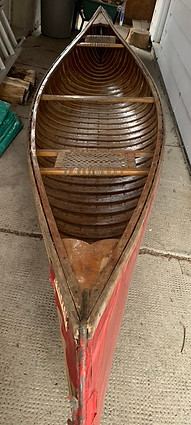The Elgin
Background
The Elgin is named for the plastic label tacked on to the bow of the canoe. I purchased it off a Kijiji in Westport, Ontario. The seller indicated he had purchased it from a farmer who had it stored in a barn. His intention was to restore it himself but couldn't eat the frog. So he put it up for sale. I am going to guess I am the third owner. Oddly, there are many similarities between this canoe and Sandy's Canoe. Both have seats made from woven rawhide, both have exact bow and stem deck design, and same hull profile.
Things I know about this canoe:
-
It was already in rough shape when the previous owner purchased it- I will assume it probably hasn't been in the water for a number of years.
-
Duct tape was removed from the bow end which indicates a quick repair for a bigger problem (the duct tape was also painted over so this tells me there were no bigger restoration plans for this canoe and it was probably left to rot). It was also suffering water damage to the wood so I am guessing this canoe was left upside down, uncovered outside (allowing water to drain to the bow and stern ends).
-
The middle section of the keel was cut away and replaced which shows me the previous owner was short on resources, time, and possibly direction.
-
I could see only one set of tack holes when the canvas was removed- meaning it has never been re-canvased.
-
No discolouration or noticeable differences in the planks and ribs which lets me know that no previous wood repairs have occurred.
-
It had a plastic label tacked onto the bow of the canoe. It is a label used by the Simpsons Sears company for their line of watercraft- Elgin- I have no idea why someone did this because the Elgin series was not a canoe it was a motor boat.







Repair Work
At first look, the Elgin seemed like it was in really good shape, in terms of ribs and planks but on further inspection, the water damage left on the Bow and Stern decks requireed replacement. Again, as I pulled back the ceader planks I am replacing them with pine (don't know if its a sin but as long as the canoe is well cared for, it should be good).




Spot the Differences

I have to admit, canvassing the canoe is my favourite part of the restoration process. It is detailed and requires a lot of my attention. There is nothing better than tuning in the CBC on a Saturday and spending the day tacking canvas onto the canoe. I will often put my ear to the hull and listen to the canvas stretch tight as I hammer in the tacks.




It's been several weeks since I have done any work on the Elgin- I have been waiting to apply the filler until the weather gets warmer. Yet as the days get warmer I had a window of opportunity. I have been using a rubberised mastic I found online from Orca Boats in Vancouver, BC. I will apply 3 coats over the canvas before I replace the keel.



The Keel
There is some debate on whether a keel is necessary or not. Some believe it helps in tracking the canoe or adds to the stability of the canoe in the water. Personally, I have paddled canoes both with and without keels and I don't find much of a difference. It would be easier to restore the Elgin without a keel but for the purpose of protecting the hull from abrasion in shallow water, I will install a keel. In addition, this canoe (Huron Canoe) was originally built with a keel so I want to keep to the original design.
The Elgin originally had a Tee keel made in three sections. I thought it would be easier to replace the whole keel rather than repair the three sections. However, I will replace it with a shoe style instead of the tee design.




I have applied 4 coats of a polyurethane paint and decided to keep with the original Red colour of the canoe. Once the canvas has been painted I will reinstall the gunwales and the brass stem bands.

Adding the Stem Band to Stern and Bow
I tried a bunch of different ways to keep the brass stem in place while I screwed it in to the bow and stern. I first tried to do one screw at a time while holding the stem band-nope. Then, I tried to hold it to the ends using straps- nope. The best method for me was to duct tape it into place while I marked the holes. Seems not ideal but it worked and I got a decent fit onto the canoe. I put a little marine silicone on each of the screws to prevent water damage.




